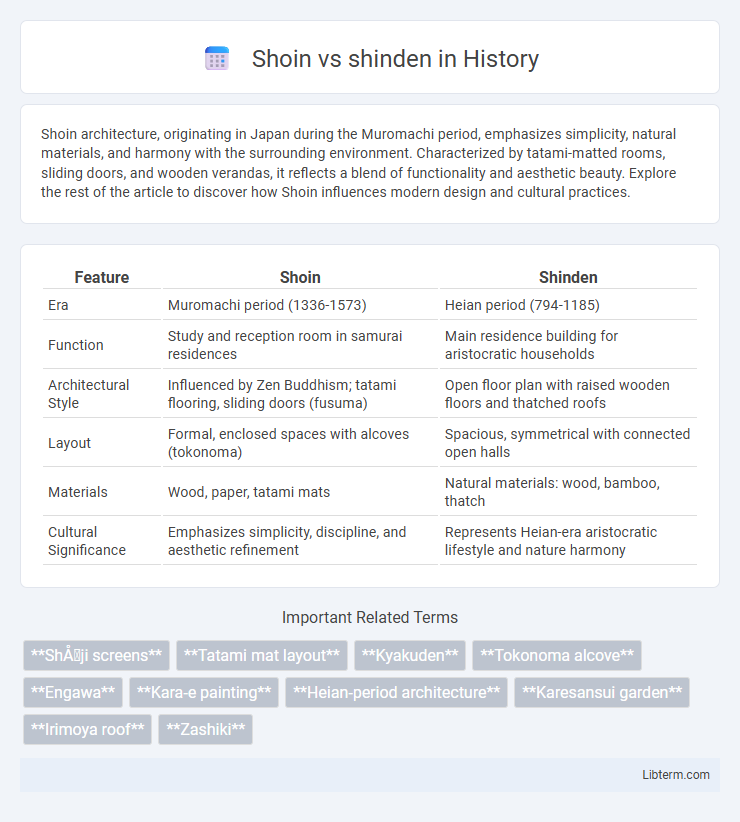Shoin architecture, originating in Japan during the Muromachi period, emphasizes simplicity, natural materials, and harmony with the surrounding environment. Characterized by tatami-matted rooms, sliding doors, and wooden verandas, it reflects a blend of functionality and aesthetic beauty. Explore the rest of the article to discover how Shoin influences modern design and cultural practices.
Table of Comparison
| Feature | Shoin | Shinden |
|---|---|---|
| Era | Muromachi period (1336-1573) | Heian period (794-1185) |
| Function | Study and reception room in samurai residences | Main residence building for aristocratic households |
| Architectural Style | Influenced by Zen Buddhism; tatami flooring, sliding doors (fusuma) | Open floor plan with raised wooden floors and thatched roofs |
| Layout | Formal, enclosed spaces with alcoves (tokonoma) | Spacious, symmetrical with connected open halls |
| Materials | Wood, paper, tatami mats | Natural materials: wood, bamboo, thatch |
| Cultural Significance | Emphasizes simplicity, discipline, and aesthetic refinement | Represents Heian-era aristocratic lifestyle and nature harmony |
Introduction to Shoin and Shinden Architecture
Shoin architecture, emerging during the Muromachi period, is characterized by its formal reception rooms, tatami-matted floors, and sliding fusuma doors, reflecting a refined aesthetic suited for samurai residences. Shinden architecture, prominent in the Heian period, features large, open, raised-floor buildings with expansive verandas, designed to harmonize with natural surroundings and accommodate aristocratic lifestyle. Both styles influenced Japanese residential design, with Shoin emphasizing structured interior spaces while Shinden prioritized fluidity between indoor and outdoor environments.
Historical Background and Evolution
Shoin architecture originated during the Muromachi period (1336-1573) as a formal residential style featuring tatami mats, sliding doors, and alcoves for art display, reflecting samurai culture and Zen influence. Shinden style, dominant in the Heian period (794-1185), emphasized grand, open layouts with elevated wooden structures and extensive gardens, designed for aristocratic leisure and aesthetics. Over time, Shoin evolved from Shinden by integrating enclosed spaces and refined interior elements, marking a shift toward more structured and intimate living environments in Japanese architecture.
Core Design Principles of Shoin
Shoin architecture centers on asymmetry, natural materials, and modularity, reflecting Zen Buddhist aesthetics and samurai lifestyle. Core design principles include tatami mat-based floor layouts, sliding fusuma panels, and tokonoma alcoves for art display, fostering tranquility and functional adaptability. This contrasts with Shinden style's grand, symmetrical, and open-plan design, emphasizing ceremonial spaces over Shoin's intimate and versatile room configurations.
Key Features of Shinden Architecture
Shinden architecture, prominent in Heian period Japan, features an elevated main hall (shinden) with a symmetrical layout, surrounded by subsidiary structures connected by covered corridors. Key elements include a spacious, open interior with tatami-matted floors and sliding doors (fusuma) that create flexible living spaces, promoting harmony with nature through gardens and water elements. Unlike the Shoin style, Shinden emphasizes formal ceremonial spaces and natural integration, reflecting aristocratic aesthetics and religious symbolism.
Spatial Organization and Layout Comparison
Shoin architecture emphasizes a hierarchical spatial organization with dedicated areas like the tokonoma alcove, chigaidana shelves, and an asymmetrical layout reflecting social status and seasonal use. In contrast, shinden style showcases a more open and symmetrical layout centered around a large central courtyard, promoting fluid movement and visual connections between buildings. The Shoin's compartmentalized rooms contrast with the Shinden's expansive corridors and open verandas, highlighting differing functional and aesthetic priorities.
Influences and Cultural Significance
Shoin architecture, emerging during the Muromachi period, heavily influenced Japanese residential design by emphasizing formal spaces for reception, study, and governance, reflecting Confucian ideals and the samurai class's social order. Shinden style, originating in the Heian period, embodies aristocratic culture with its open, airy layouts and integration with gardens, symbolizing the aesthetics of court life and Buddhist principles of harmony with nature. Both styles significantly shaped Japan's architectural heritage, with shoin reinforcing structured social hierarchy and shinden expressing poetic elegance and spiritual tranquility.
Materials and Construction Methods
Shoin architecture primarily employs wooden frameworks combined with plaster walls and tatami mat flooring, emphasizing refined joinery techniques without nails, creating elegant, lightweight interiors. Shinden architecture uses natural materials like cypress wood and thatch roofing, with open-plan layouts supported by large wooden pillars and raised wooden floors, reflecting organic construction methods of the Heian period. Both styles integrate durable timber but differ in surface treatments and structural openness, with shinden favoring airy, expansive spaces and shoin focusing on compartmentalized, intricate interiors.
Decorative Elements and Interior Details
Shoin architecture features tatami mats, shoji screens, and intricate wooden transoms (ranma) with carved or painted decorations, emphasizing refined elegance and detailed craftsmanship. Shinden style interiors include expansive open spaces with minimal partitions, polished wooden floors, and sliding doors adorned with painted or gilded panels reflecting Heian period aesthetics. Both styles utilize decorative elements that enhance spatial harmony but differ in complexity, with Shoin interiors showcasing more ornate and symbolic motifs.
Functional Uses: From Aristocrats to Samurai
Shoin and shinden architectural styles reflect distinct functional uses shaped by social hierarchy in feudal Japan. The shinden style, predominant in aristocratic mansions during the Heian period, emphasized large, open spaces for ceremonial functions and aesthetic appreciation, catering to court nobles. The shoin style evolved from the Muromachi period, designed for samurai residences with smaller, more compartmentalized rooms, incorporating features like tokonoma alcoves and sliding doors to support practical governance and military administration.
Legacy and Impact on Modern Japanese Architecture
Shoin architecture, characterized by its formal reception rooms with tatami flooring, sliding doors, and built-in alcoves (tokonoma), significantly influenced the aesthetic principles and spatial organization in modern Japanese homes, promoting minimalist design and multifunctional spaces. Shinden style, originating from Heian period aristocratic residences, emphasized open layouts and integration with natural surroundings, which continues to inspire contemporary architectural approaches favoring harmony between indoor and outdoor environments. The legacy of both Shoin and Shinden styles endures in modern Japanese architecture through their contribution to sustainable design, seamless indoor-outdoor transitions, and the enduring cultural value placed on simplicity and natural materials.
Shoin Infographic

 libterm.com
libterm.com